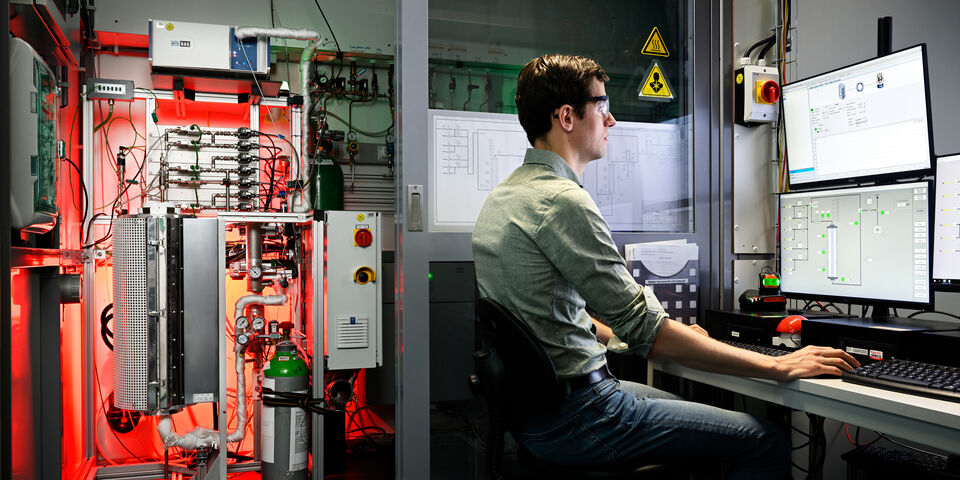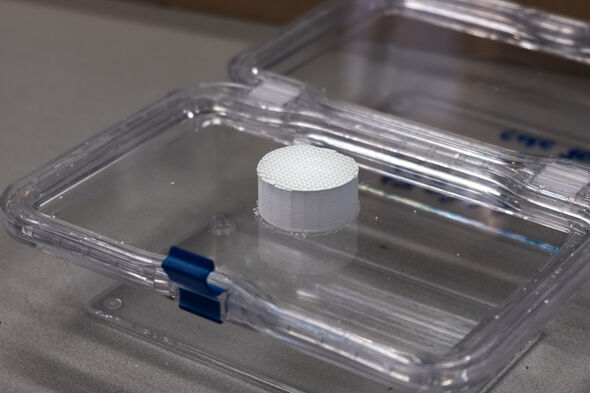Home stretch | Keeping reactor hot with holes
TU/e chemical engineer Leon Rosseau investigated how to control the temperature in a chemical reactor as efficiently as possible. To do so, he used 3D printed obstacles to determine which shape works best. A research story about cold beer and shortcuts at IKEA.
Do you want to keep your drinks nice and cool at a garden party or festival? Then try placing them between water with ice cubes and sprinkle a generous amount of table salt on top. You’ll get to enjoy an ice-cold beer in no time. This is because of heat transfer; in this case from the drink to the surrounding, extra-cold water. Heat transfer also takes place in chemical reactors, explains PhD candidate Leon Rosseau. But where a cold drink is desirable, a cooling reactor is usually not, because the lower temperature has a negative impact on the chemical reactions. Therefore, Rosseau has spent the past few years investigating how to better regulate the temperature in a chemical reactor with the help of 3D printed shapes. On Wednesday, February 7, he will defend his doctoral research at the Department of Chemical Engineering and Chemistry.
We talk to Rosseau via a video connection; he moved to Denmark with his wife and dog in mid-December. It’s very cold and there’s lots of snow – “you’re immediately put to the test.” There, he is working on a sustainable way to heat reactors, with electricity. He enjoys the work. Although he is currently taking a more application-oriented approach to energy transition, the questions and challenges largely overlap with his doctoral research.
Springboard
“Temperature is very important in a reactor. Especially in reactions that cool themselves, like when producing hydrogen from natural gas. The rate at which heat is added determines how the reactor operates; many chemical reactions require heat to take place correctly.” Simply turning the knobs to increase the temperature often has an adverse effect, according to Rosseau. So how can you regulate the temperature in a reactor without affecting the rest of the chemical process? To find the answer, Rosseau delved into the world of catalysts. These are substances that contribute to chemical reactions but don’t react themselves. “Imagine standing in front of a tall wall. You could probably climb over it yourself, with some difficulty perhaps, but if you use a springboard, it’s much easier and faster. The same is true in chemistry. If you want a reaction to occur that transforms a molecule into another molecule, you must first overcome an energy barrier. A catalyst lowers that wall a bit.”
Optimal blocking
And then there is the chemical reactor itself. The setups Rosseau has been studying have standard long, thin tubes, making it easier to add heat to the system. This is not ideal because you need a lot of tubes, leading to significant costs, Rosseau says. “Have you ever walked through IKEA? You can’t just quickly grab something from a specific department; you have to move with the crowd along the main path so you’re led through the entire store. Fortunately, there are also shortcuts, and you can cut straight through to the kitchenware section via the lighting department. And that’s basically what we did, we built a chemical infrastructure. We direct the gas from left to right through the reactor - which is called a cross-flow - by inserting blocks. Because of that cross-flow, the gas is constantly hitting the wall of the reactor, which is hot. That way, the temperature is kept at the right level. But we realized that we can make the process much more energy-efficient by making tiny holes in the blocks. Then the compressor doesn’t have to press as hard to get the gas through the system. A win-win situation.”
Warm sweaters
With the aid of a 3D printer, Rosseau was able to test various structures of his catalyst very easily. It is made of porous ceramic material infused with powdered nickel. He shows an example made of plastic. You can’t just put the real catalysts on your hand because of the ultra-fine, carcinogenic nickel powder – you would need a proper mask and good gloves to do so. “Through these tests, we ultimately managed to describe the optimal blocking structure. What shape, which holes - how many and how deep - but also how exactly you place the blocks in the setup. This works perfectly well on a lab scale and ideally, we now want to scale up to a commercial application. That will require quite a bit of work, though. Because we already ran into several problems with our printing technique when we went from a two-centimeter catalyst to a four-centimeter one. You can print the ceramic paste in a perfectly fine shape, but keeping it stable while drying is a challenge. And for a commercial catalyst, we have to go up to a size of 10 cm. Fundamentally, we have made great strides and we now have a much better understanding of how various parameters work in a reactor.” Rosseau is now putting that knowledge to use at the Danish company Topsoe, where he is investigating whether he can use his catalyst technology to make the world a little greener. After obtaining his doctorate, he plans to learn the language. But he is currently mostly invested in woollen heat retainers, he laughs. “Thankfully, spring is in sight.”



Discussion